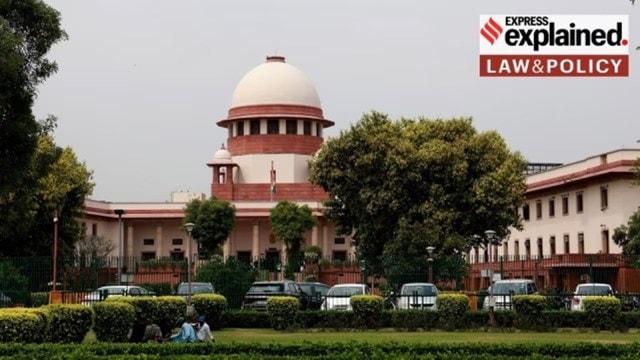SC asks Centre, CBI, Haryana to respond in a ‘digital arrests’ case: the problem, what courts have said earlier
In the first two months of 2025 alone, 17,718 cases of digital arrest were reported. A 'digital arrest' scam usually begins with a phone or video call from someone posing as a government official. Once the conversation starts, the caller builds credibility.
 The Supreme Court's verdict has put a spotlight on this forested habitat, which has seen illegal mining in the past. (Photo: File)
The Supreme Court's verdict has put a spotlight on this forested habitat, which has seen illegal mining in the past. (Photo: File)Calling it a “matter of grave concern”, the Supreme Court on October 17 took suo motu cognisance of matters pertaining to “digital arrests”. The trigger was a case filed by a senior couple from Ambala, Haryana, who had lost over Rs. 1 crore to a group that convinced them they were under investigation by the CBI and Enforcement Directorate. The fraudsters sent them court orders that looked genuine, carrying what appeared to be the seal and signatures of the SC itself.
A Bench of Justices Surya Kant and Joymalya Bagchi said that “the fabrication of judicial orders bearing forged signatures of the judges strikes at the very foundation of public trust in the judicial system besides the rule of law. Such action constitutes a direct assault on the dignity and majesty of the institution. Therefore, such grave criminal acts cannot be treated as an ordinary or routine offence of cheating or cybercrime.”
The court asked the Union Home Ministry, the CBI, the Haryana Home Department and the Ambala Cyber Police to respond, and sought assistance from Attorney General R Venkataramani.
What does a ‘digital arrest’ mean?
While there is no legal definition of the term, it is widely used to describe a pattern of cyber fraud that has become prevalent. It usually begins with a phone or video call from someone posing as a government official. The caller claims to be from the police, CBI, ED or some other law enforcement agency, and tells the person at the other end that their account, SIM card or ID has been used in a criminal offence.
Once the conversation starts, the caller builds credibility. They send documents that look official, sometimes using fake seals or court logos, and convince the victim that they face arrest. The fake officers then stage an online investigation. They show police uniforms on video calls, display screenshots of fake FIRs, etc. Then comes the demand to transfer money to a “supervision” or “safe” account while the case is verified. The person on the line believes they are cooperating with an investigation, not being robbed.
Most calls follow a similar pattern. The victims are told not to leave their houses or speak to anyone, placing them in a kind of psychological custody. The scammers already have access to the victim’s personal details, bank accounts, Aadhar, and even old transaction histories. They study the person’s routine before calling. That background detail makes their story convincing.
How big is the problem?
The Minister of State in the Ministry of Home Affairs, Bandi Sanjay Kumar, reported to the Rajya Sabha in March that the National Crime Records Bureau (NCRB) does not maintain separate data on digital arrest scams. The official figures are based on incidents of digital arrest scams and related cyber crimes reported on the National Cyber Crime Reporting Portal (NCRP).
Data from the NCRP shows a consistent rise in reported incidents and financial losses linked to digital arrest scams. Reported cases increased from 39,925 in 2022 to 123,672 in 2024, with the defrauded amount rising from Rs. 91.14 crore to Rs. 1935.51 crore in the same period. In the first two months of 2025 alone, 17,718 cases were reported, leading to a loss of Rs 210.21 crore.
All figures are based on reports submitted to the NCRP under broader categories of cybercrime. The Indian Crime Coordination Centre has taken several actions. It has facilitated the blocking of 3,962 Skype IDs and 83,668 WhatsApp accounts used in such scams. Authorities have also blocked 7.81 lakh SIM cards and 2,08,469 IMEIs based on police reports. Measures are in place to identify and block spoofed international calls that appear to come from Indian numbers.
What have the courts said so far?
Several HCs have flagged these scams over the past year.
The Rajasthan HC, in January, took suo motu cognisance of the trend. Terming ‘digital arrest’ as “a sophisticated and deceptive form of cyberfraud” that has no legal standing in India, the Bench said that these scams are effective due to “manipulative psychological tactics, often leading the victims to believe they have been implicated in serious criminal activities.”
In September, the Delhi HC refused pre-arrest bail to a man accused of a Rs 1.75 crore scam. Justice Amit Mahajan said that “such crimes are on the rise and the same tend to be significantly harder to crack due to the boon of technology that is effectively misused by crooks to wreak havoc and evade the law enforcement.”
In Mumbai, the Bombay HC in March heard the case of 71-year-old Leela Parthasarathy, a retired teacher who transferred Rs 32 lakh to fraudsters posing as ED officials. She believed that the calls were real because the scammers showed her identity documents and court letters that looked authentic. When she approached the police, her complaint was not registered for two months.
The Bench of Justices Revati Mohite-Dere and Neela Gokhale criticised the police for the delay and asked how senior citizens were expected to handle such pressure without help. They also questioned the cybercrime helpline 1930, which, in this case, was unreachable. The court directed the police to train officers to use the national cyber portal for immediate reporting and tracing of funds.
- 01
- 02
- 03
- 04
- 05






































